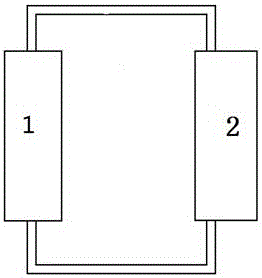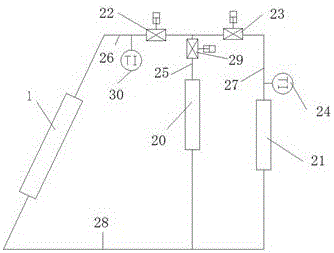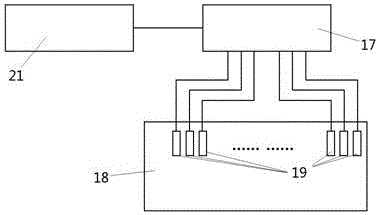Solar thermal collector system and sounding stave thereof
A technology of solar heat collectors and staves, applied in the field of solar energy, can solve problems such as the limitation of note position and display mode, insufficient absorption of solar heat, and poor practicability, so as to avoid heat collection blind spots, simple structure, and improve heat absorption efficiency effect
- Summary
- Abstract
- Description
- Claims
- Application Information
AI Technical Summary
Problems solved by technology
Method used
Image
Examples
Embodiment Construction
[0038] The specific embodiments of the present invention will be described in detail below in conjunction with the accompanying drawings.
[0039] figure 1 A solar heat collector system is shown, the system includes a heat collector 1 and a heat utilization device 2 thereof, and the heat collector 1 and the heat utilization device 2 are connected by pipelines.
[0040] The structure of the collector is as figure 2 As shown, it includes a heat collecting tube 4, a reflector 3 and a heat collecting plate 5, and two adjacent heat collecting tubes 4 are connected by a heat collecting plate 5, so that a plurality of heat collecting tubes 4 and adjacent heat collecting plates 5 A tube-sheet structure is formed between them; the solar heat collector system includes two tube-sheet structures, a certain angle is formed between the two tube-sheet structures, and the direction of the angle is curved with the circular arc line structure of the reflector The directions are opposite, and...
PUM
 Login to View More
Login to View More Abstract
Description
Claims
Application Information
 Login to View More
Login to View More - R&D
- Intellectual Property
- Life Sciences
- Materials
- Tech Scout
- Unparalleled Data Quality
- Higher Quality Content
- 60% Fewer Hallucinations
Browse by: Latest US Patents, China's latest patents, Technical Efficacy Thesaurus, Application Domain, Technology Topic, Popular Technical Reports.
© 2025 PatSnap. All rights reserved.Legal|Privacy policy|Modern Slavery Act Transparency Statement|Sitemap|About US| Contact US: help@patsnap.com



